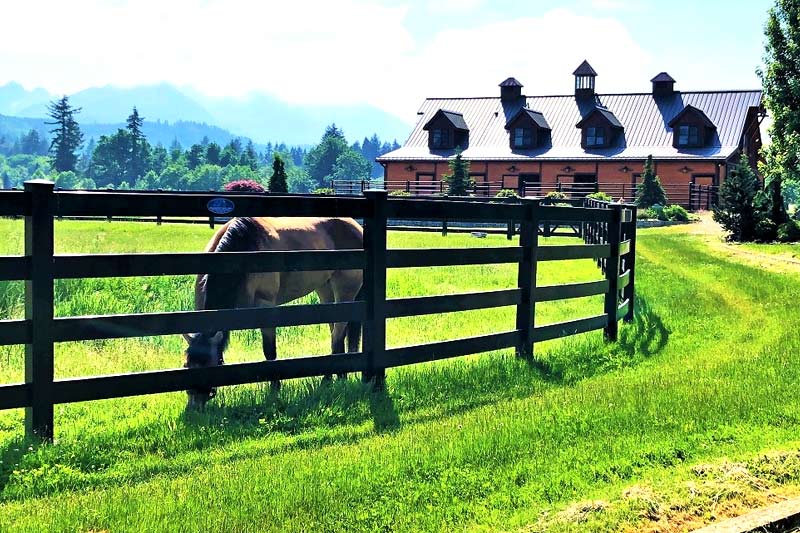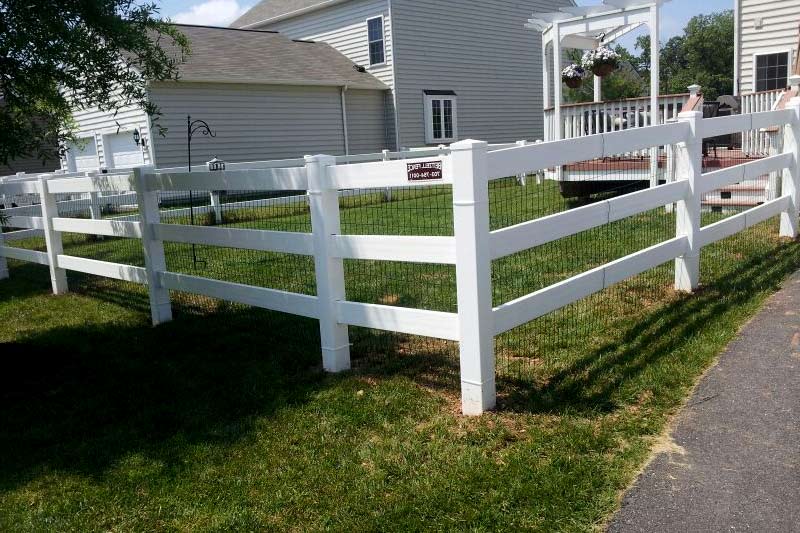How much does it cost to install pipe fencing, widely regarded as the premiere fencing option for agricultural settings?
You will pay $10-$15 per foot for pipe fencing. The price includes the cost of materials and installation. The average cost of materials ranges from $2 to $20 per foot.
How much you will pay for the pipe fencing projects depends on the size of the land.
What we cover
ToggleWhat is a pipe fence
A pipe fence is a fence made of metal pipes. It is corrosion-resistant and robust. Consequently, it has a useful lifespan of about 20-30 years.
Many farms use pipe fences. However, you can use them on any other type of land.
Factors affecting pipe fence cost
Fencing material
The fence material you choose to use determines how much land fencing will cost.
Metal makes most pipes for fencing. The price of steel has been rising over the last few years. As a result, it will cost you more to fence your land with pipe fencing than wooden posts or any other cheaper material.
You will pay $7-$10 per foot of pipe fencing, while it costs $3-$9 per foot when you use wooden posts.
Further, the fencing material you choose depends on the type of land you are fencing and its use.

Size of the land
The size of the land to fence implies how much money you will spend. The larger the plot, the more you will pay.
The amount of materials you need depends on the size of the land. The more materials you need, the more you will spend on fencing.
Further, the larger the land, the more you pay for labor.
Pipe fencing is suitable for any size of land. You can use it in small plots or large farms.

Land topography
How the land looks also determines how much you spend on fencing.
It costs more to fence a sloping land than flat land.
Since sloping land is harder to work on, it will cost you more to fence it.
When working on flat land, the work will move fast and will not require advanced tools or carrying heavy loads over large distances.
Usually, sloping land needs grading to make it easy to work. The cost of grading increases the cost of fencing.
Labor cost
You can DIY or hire a pro to help install a fence on your land. You will save on labor costs if you DIY. However, fencing land is a job best left to professionals.
The larger your land, the more you will pay for fencing. The slopier your land, the more difficult it is to work on, and the more you will pay.
Labor cost is additional to the material cost. Hence, increasing the fencing cost. Labor costs depend on the location of your land, the expertise of those you hire, and more.
Fence height
The higher the fence, the more it costs.
Fences are 6ft high. However, depending on the land you are fencing, you may need a higher one. Privacy fences are at least 8ft in height.
The higher the fence, the more materials it needs. Thus, the higher the cost. It will also take longer to install, increasing the labor costs.
Obstacles on the land
The more obstacles on the land, the higher the fencing cost. Trees are some of the fencing obstacles.
If there are trees on the fencing path, you have to remove them or go around them. Tree removal is expensive and is an additional cost when fencing your land.
If you have to go around the trees, you increase the distance for fence laying. As a result, you will need more posts which increases the cost of fencing.
Existing fence
Replacing an existing fence increases the cost of fencing. The pros you hire will charge extra for old fence removal. Also, it increases the time for new fence installation.
It is best to remove the fence before your hired pros get to the site. It will help you save money.
If your existing fence is usable, you can repair it. It will save you the cost of purchasing and installing a new one.
Benefits of pipe fencing
Strength
Metal pipes have sufficient tensile strength compared to other fencing posts. They can withstand strong hits without denting or breaking, unlike wooden posts. Steel pipes are difficult to ram down when properly installed.
Cost-effective
While it may be expensive to purchase and install pipe fencing, its usage is cost-effective. Once installed, it requires little maintenance. Since it does not attract pests, you do not have to keep inspecting and spraying chemicals.
Additionally, it is corrosion-resistant. You will not incur additional expenses to paint it regularly. Steel pipe fencing is also fire-resistant.
Durability
Steel pipes have a long lifespan. They last for 25-30 years before you have to replace them. Combined with its low maintenance cost, you have a fence that you will not need to spend money on after installation.
Eco-friendly
Recycled scrap metal is the source of material to manufacture pipe fencing. Thus, making it an environmentally friendly product. It does not leave any residue on the ground as it ages. Additionally, the pipes can be recycled and made into other steel products or new pipe fencing when removed.
Easy to install
Steel fence pipes are not as bulky as wooden posts making them easy to work.
When you use hydraulic drivers, you can install the pipes without digging or pouring concrete. Thus, you save time when working with steel than other materials.
Alternative farm fencing methods
High tensile wire fence
A high tensile wire fence can either be electric or non-electric. You will need six strands of the wire for proper fencing.
It costs $0.12-$0.18 per foot to purchase the non-electric high tensile wire. You will pay $0.18-$0.72 per foot to purchase the electric tensile wire fence materials. You will also pay additional labor costs to install the fence on your land.
It is durable and low-maintenance. Suitable for ranch fencing due to its high tensile strength. Animals get easily entangled by the wire due to its low visibility. You can use markers to make it more visible.
Vinyl horse fence
You will pay $0.90 to $1.60 per rail per foot of vinyl horse fence. Its price is considerably high compared to steel pipe fencing or other materials.
Vinyl is durable and requires little maintenance. It is best used in warm climate regions. In cold regions, it can become brittle and break.
Vinyl fences can be used at home and on agricultural land. It is safe for animals and people. Further, it does not break easily and will not injure animals or people.

Split rail fencing
You will pay $12-$30 per foot to purchase materials and install split rail fencing on your land. It keeps animals from straying and demarcates land easily.

Barbed wire
Barbed wire is the cheapest farm fencing alternative. It costs $0.03-$0,05 per strand per foot. It is ideal for farmland. It keeps animals enclosed and safe.
Barbed wire requires regular inspection and tightening if it gets loose. It has sharp parts that may injure your animals when they get too close.

No climb fence
Post and rail or field fences can also add no climb mesh to better protect livestock. It costs $1.39-$1.89 for materials only. It is attractive and strong enough to keep animals from straying or knocking them down. It is best installed in even landscapes and may require regular tightening to keep it working well.

DIY vs hiring a pro cost
Depending on the fence materials you use, you can DIY or hire a pro for fence installation.
DIY pros
- Save money. You only spend money on the purchase of materials. It will cost you $2-$20 per linear foot to install a fence by yourself.
- Install the fence as you want.
DIY cons
- You may have to hire tools if you do not have your own. It may use up the money you saved and more.
- Likely to make errors if you do not know how to install fences.
- May take you a lot of time.
Pros of hiring a pro
- Saves time since the work is completed by trained professionals.
- No errors.
- Pros are insured to pay for medical injuries and other accidents at the site.
- May bring their materials
- High quality of workmanship.
Cons of hiring a pro
- Expensive. It costs $4 to $26 for a pro to install a fence on your land. The cost includes materials and labor.
How to hire a pro for your pipe fencing
Homegardenguides.com is a free tool to hire professional fence installation service providers.
It connects homeowners to professionals in the following easy steps.
- Enter your zip code at the top of the tool.
- Fill in the form to provide more details about the fencing service you need.
- You will receive three or four quotes and advice from professional fence materials and installation companies
- Contact and hire a land clearing service that falls within your budget.

Factors to consider when choosing a fence design
Cost
When choosing a fence design, you must have a budget. Your budget will provide the direction in how you design your fence.
The higher the budget, the more expensive materials you can get and the higher you can pay pros. Consequently, the more exquisite the fence design you can get.
A low budget allows you to purchase low-priced fence materials and limits you to affordable fence designs.
Fencing costs quickly add up. Thus, the higher your budget, the better a fence design you can get.
Lifespan
When choosing a fence design, you need to consider the durability of the fence. How long a fence life is determined by the fence material. Some have a longer lifespan than others.
Pests and rotting affect the lifespan of wooden fence posts. Consequently, wooden fences will not have a long lifespan.
Steel pipe fences are not affected by pests and rotting, and neither do they rust. Thus, they have a lifespan of 25-30 years, They are also affordable to purchase and are low maintenance, making them ideal for fence materials.
Intended use
The intended use of a fence determines its design. A fence installed at home will have a different design from one at a farm. A privacy fence has a different design from a picket fence even when you use the same material.
When choosing a fence design, ensure that you know where the fence will be installed. The location of the fence also determines its intended use.
Maintenance
When choosing a fence design, determine how much money and time you will spend to maintain the fence. The higher the maintenance cost, the more expensive it is to keep or install the fence. A fence should be easy to maintain.
Different fence materials have different maintenance requirements. Wooden fences require more maintenance than other types. They have to be treated and painted to prevent pests and rotting. They also need proper drainage to prevent them from rotting when they touch the water.
Other materials may only require painting every few years.
Installation
Depending on the design you choose, you could DIY or hire a pro to install the fence. The easier the design, the easier it is to install the fence by yourself. For a complicated design, you will have to hire a pro to install it.
Permits
Depending on where you live, you may need a permit to install a fence. Consult with a pro to find out if you do.














